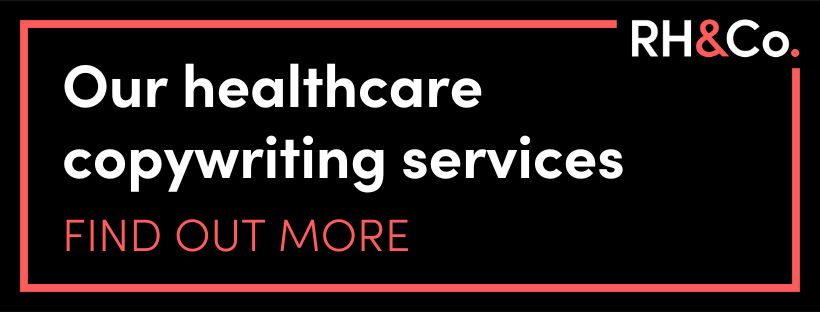

Marketing health: the 3 most common communication challenges in the healthcare industry
In theory, marketing healthcare should be easy. After all, it’s something that everyone knows they need – whether it’s hospital treatment for an urgent condition, residential care for a loved one or sex therapy and education (ok, maybe that one’s a harder sell!).
But in reality, communicating what you do as a healthcare organisation can be as delicate and as challenging as a triple bypass.
You need to find the right way to promote the brilliance of what you do without promising benefits you can’t guarantee. You need to strike the right balance between your various audiences and stakeholders.
And above all, you need to help your audience find peace of mind that they’re putting their trust in the right team of experts.
TL:DR
- Challenge 01: Compliance
- Challenge 02: Diverse stakeholders
- Challenge 03: Trust
- Getting healthcare comms right
Challenge 01: Compliance
When you put out any kind of healthcare marketing and content, the first challenge is always making sure it’s accurate and compliant. You’re not advising people on when to belt a swing dress or the right order to watch the Marvel movies – you’re helping them make decisions about their health and wellbeing.
That means whatever claims you make about your products or services are going to be scrutinised more than most, starting with the various regulations and codes of practice that govern healthcare marketing.
In the UK, for example, the Advertising Standards Authority (ASA) and Committee of Advertising Practice (CAP) have specific codes governing what claims you can make depending on what kind of medicine, treatment or device you’re marketing.
And the ASA is just one of many threads. Its codes on healthcare advertising are also supported by the Blue Guide from the Medicines and Healthcare products Regulatory Agency (MHRA), an agency of the Department of Health and Social Care. Then there’s the European Federation of Pharmaceutical Industry Associations (EFPIA) Code of Practice, which exists to hold up integrity and ethical practice in medical communications.

SEO for healthcare brands
Even if there wasn’t this tight regulatory lattice to navigate, there’s still the matter of SEO to consider. Sites like Google don’t particularly want to come under fire if users come to harm as a result of something they found in the search results, and so they set higher standards for pages covering healthcare topics.
In Google’s case, it’s about YMYL – ie Your Money or Your Life. YMYL is a phrase Google uses to identify pages that can have a significant impact on a reader’s health, happiness and safety. If they categorise a page as YMYL content, you have to work harder to prove that content is based on verifiable facts – and avoid overselling any unproven benefits – if you want it to rank.
We worked with a probiotic brand who faced this exact challenge. They weren’t able to make certain claims about their products because parts of the certification process were still ongoing. It didn’t matter that they were confident those benefits were there thanks to their own rigorous scientific testing – until the relevant body had approved it, it couldn’t be written down.
That shifted the marketing focus onto what we did know for certain – the results that could be proven with lab study figures. Potential customers were then able to draw their own conclusions about whether the probiotics would be beneficial for them, without the risk of them being misinformed.
Challenge 02: Diverse stakeholders
After compliance, the next challenge is knowing who you’re speaking to. With healthcare, you’re rarely talking to just one audience group at a time. Patients, practitioners, regulators, investors, researchers – your campaigns and content often have to speak to multiple groups of people, sometimes at the same time. Finding the right way to land your message requires a clear strategy.
The distinctions between audiences can be incredibly subtle, as we found when writing for a regional luxury care home client a few years ago. On the one hand, their campaign needed to speak to the elderly people who might become residents at the care home, showing what that life could look like for them.
But it also needed to address those residents’ children or other family members, who are often key decision makers when it comes to care home selection. They needed a slightly different set of questions answered – chiefly, “How will my loved one be looked after here?” and “Will they be OK?”
Other times, you might be serving a much broader spectrum of audiences, all with their own segmented needs and levels of understanding. When we worked with Health Innovation Network (formerly the AHSN Network), the innovation arm of the NHS, one of their key challenges was that their website needed to be a resource for everyone from patients and healthcare workers, to researchers and innovators.
Trying to find a way to speak to everyone at once would end up with content that didn’t really answer anyone’s needs. Instead, we advised them on the UX of their website and laid out their different audience groups clearly at the top of the home page, so that site users could go directly to the content and advice tailored to them.
Challenge 03: Trust
Lastly, we come to the challenge of trust. Trust is arguably the most important challenge on this list. Not just because you’re asking patients and customers to trust you with their wellbeing, but because the other challenges of navigating compliance and the diverse needs of your audiences feed into it as well.
But trust doesn’t only come down to getting those factors right. There are also the foundational elements that every brand, healthcare or otherwise, has to nail – consistent brand tone of voice and messaging.
Finding that consistency can be difficult in the healthcare industry. You might have some content that uses the common terms for conditions or symptoms (like “blood poisoning” or “fits”) and other content using medical terms (like “sepsis” or “seizures”). One campaign might refer to “patients” while another speaks about “residents”. If you’re a large organisation or network, you’ve also got the challenge of keeping consistency across multiple departments.
Also bear in mind that in healthcare, consistency in communication doesn’t just mean what’s written down – it’s about how everyone in your organisation talks about what you do. Take our previous care home client as an example again.
Imagine somebody reading through the care home brochures and website to find care for their loved one. But while the written copy talks about the care home’s “residents”, everyone they speak to on a visit says “patients” instead. It might seem like a small detail, but it’s enough to suggest a split between how the organisation wants to be seen and how it actually operates.

Getting healthcare comms right
Getting healthcare comms right starts where all good comms should – at the strategy stage. More than in any other sector, with such a big emphasis on transparency and trust, you need to truly understand your own brand (your value proposition, differentiators, limitations and so on) as well as your various audiences and your competitive landscape.
From there, it’s about creating brand voice and messaging guidelines that empower internal teams and external suppliers such as marketing agencies to be consistent throughout all of your comms, in any format and on any channel. And having a robust content strategy that allows you to build that brand messaging into a solid and lasting reputation that engenders the kind of trust you need to win your audience over.
At RH&Co, we’ve worked with healthcare brands from a small pharma startup to an international hospital group, from a healthtech app to a luxury care home group. If you need support with clarifying and communicating your message or building your brand reputation and authority, get in touch today.
Back to hompeage








